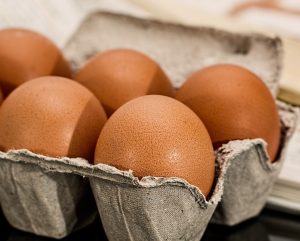 Eggs are such a common kitchen staple. They appear on plates from breakfast to dinner and dessert. As such, it’s easy to take them for granted. With their impressive nutritional profile, high quality protein, good value, and versatility, eggs are hard to beat. Well, technically, they aren’t – egg whites have unique protein properties that allow them to unravel and reform. This allows them to change their texture from liquid to firm peaks of foam via the simple incorporation of air by whisking or beating. That distinguishing feature provides the foundation for many appealing dishes, from angel food cake to meringues and soufflés. This can even be a shrewd way to stretch eggs. If you want to make omelets but are short on eggs, separate and beat the whites. Then, fold them together with the beaten yolks – voilà, a puffy soufflé omelet!
Eggs are such a common kitchen staple. They appear on plates from breakfast to dinner and dessert. As such, it’s easy to take them for granted. With their impressive nutritional profile, high quality protein, good value, and versatility, eggs are hard to beat. Well, technically, they aren’t – egg whites have unique protein properties that allow them to unravel and reform. This allows them to change their texture from liquid to firm peaks of foam via the simple incorporation of air by whisking or beating. That distinguishing feature provides the foundation for many appealing dishes, from angel food cake to meringues and soufflés. This can even be a shrewd way to stretch eggs. If you want to make omelets but are short on eggs, separate and beat the whites. Then, fold them together with the beaten yolks – voilà, a puffy soufflé omelet!
Eggs and their Sustainable Packaging
And how about that unique packaging? The shells of these self-contained vessels are only about one-hundredth of an inch thick. Shells are porous to air yet they do not leak. Their unique structure provides remarkable strength, allowing them to withstand boiling water temperatures, unlike many types of commercial packaging. An egg can go from raw to cooked and then go straight into lunch bags in that same lightweight package – which is also compostable! It is true that commercial eggs are generally only available in two basic color choices, but egg shells transform easily to a rainbow of colors and artistic designs.
Anatomy and Versatile Function
Luckily for us, the yolk and white within that shell remain separate because each has unique properties which contribute to different types of cooking applications. Different components of an egg can help improve texture, emulsify mixtures, increase volume, bind coatings, add flavor, richness, and stability. Eggs also help retain and preserve moisture in baked goods. Well done, eggs!
Egg Safety
Since they are used as ingredients in so many of our meals, it is essential to recognize the importance of safe handling. Salmonella and other pathogens are frequently associated with raw eggs.
- Wash hands well after handling.
- Eat only baked cookies or cakes, never raw.
- Cook dishes containing egg to the recommended safe minimum internal temperature 160°F.
- Store decorated or colored eggs in a clean container (not a used egg carton) in the refrigerator.
- Do not eat if they have been out of the refrigerator more than two hours.
 These days, many families collect eggs from their backyard flock instead of the grocery store. Home produced eggs come with many benefits including convenience and the rewarding opportunity to be involved directly with chickens. However, steps need to be followed to reduce the risk of bacterial cross-contamination from the egg and chicken coop. Good news, CSU Extension has a Home-Produced Chicken Eggs fact sheet on safe home production.
These days, many families collect eggs from their backyard flock instead of the grocery store. Home produced eggs come with many benefits including convenience and the rewarding opportunity to be involved directly with chickens. However, steps need to be followed to reduce the risk of bacterial cross-contamination from the egg and chicken coop. Good news, CSU Extension has a Home-Produced Chicken Eggs fact sheet on safe home production.


Egg-cellent expose’ on this versatile and economical food!
Eggs are so versatile, easy to prepare and nutritious (in moderation).